NIF & PS People - 2016
September
Researchers and Teams Win Recognition
A pioneering fusion scientist and a number of NIF & Photon Science teams and individual researchers have been cited for their career accomplishments and their institutional, science and technology, and publications achievements.
Fusion Technology Award Honors LLNL Scientist’s Career
Veteran fusion researcher Wayne Meier has been selected by the Institute of Electrical and Electronics Engineers’ (IEEE) Nuclear & Plasma Sciences Society to receive the society’s 2016 Fusion Technology Award. The award will be presented at the 2017 Symposium on Fusion Engineering June 4-8 in Shanghai, China.
The award recognizes Meier’s 40-year career of research and leadership advancing the science, technology, and integrated assessment of fusion power plants. “It’s a satisfying recognition of all my years in the field of fusion technology,” Meier said. “To be acknowledged by this committee, who I’ve worked with many years on different technical projects as well as international conferences, is an honor.”
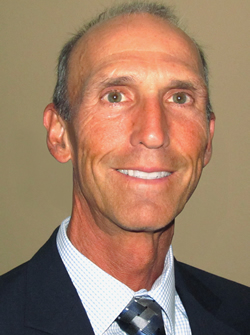 Wayne Meier
Wayne Meier Meier retired in September as the deputy program leader for the Laboratory's Fusion Energy Sciences Program (FESP). He was notified of the award two weeks after retiring, “so this is a nice cap on my career,” he said. He will continue with the Lab as a visiting scientist sharing his knowledge and expertise in fusion technology.
Meier contributed to studies on fusion chamber design, nuclear analysis, systems integration, and systems analysis since beginning his work at the Lab in 1976. During his career he authored or co-authored more than 150 technical papers, and he volunteered for fusion technology groups including IEEE, the Nuclear Plasma Sciences Society, and the American Nuclear Society Fusion Energy Division. In 2015, Meier won a Fusion Power Associates Special Award for his role in fusion power development and his service on journal editorial boards.
“Over the past 40 years we’ve moved from conceptual design studies to the understanding and the development of the actual technologies,” he said. “The hardware required to make fusion energy a reality has come a long way. We now have large research facilities like the National Ignition Facility at LLNL, and the international burning plasma experiment, ITER, under construction in France, that are critical steps on the path to fusion energy.”
Meier cites his work with magnetic fusion energy for the Fusion Nuclear Science and Technology Research Needs Workshop as one of the projects he is most proud of. His contribution to the national effort allowed him to work with a range of scientists across the U.S. fusion community, looking at how technologies for the fusion fuel cycle, power conversion, and systems integration interfaced with plasma physics. In the 1990s, he was project leader for a Department of Energy study on inertial fusion energy power plants that produced one of the most thorough conceptual design reports on the subject to that time.
FESP program leader Harry McLean and FESP senior scientist Don Correll, deputy director of LLNL’s Center for High Energy Density Science, nominated Meier for the award. “We are thrilled with this recognition for Wayne,” McLean said. “Much of the international respect that he has earned over the years was due to his natural leadership, organizing, and cross-discipline team-building skills. He was always ahead of the curve in delivering results and always ready with sound judgment and clear, concise thinking. We are very grateful that fusion-related efforts across LLNL will continue to benefit from his knowledge and advice.”
NIF&PS Researchers and Teams Win Laboratory Awards
Several NIF & Photon Science teams and individual researchers recently were cited by LLNL for their career accomplishments and their institutional, science and technology, and publications achievements in the past year.
Early and Mid-Career Recognition Program
Pierre Michel, Steve Ross, and Tayyab Suratwala were selected for the Laboratory’s Fiscal Year 2017 Early and Mid-Career Recognition (EMCR) Program.
The EMCR Program recognizes scientific and technical accomplishments, leadership and future promise demonstrated by LLNL scientists and engineers early in their careers—from five to 20 years since they received their most recent degree. Winners receive a cash award and institutional funding, approximately equivalent to 20 percent support for one year, to pursue research activities in their area of interest.
“Recognizing and encouraging early and mid-career technical staff is a key element in our strategy for retaining talent,” said LLNL Director Bill Goldstein. “This program rewards employees at this stage in their careers who are exceptionally accomplished and show potential for future leadership.”
Pierre Michel's expertise focuses on laser-plasma interactions. He developed the physics basis for energy transfer between crossing laser beams in NIF hohlraums which is used routinely in NIF ignition experiments for symmetry control. 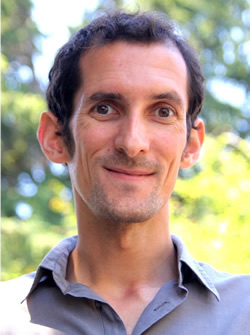 Pierre Michel He received the 2015 Edouard Fabre Prize for his pioneering research into cross-beam energy transfer, and he and several of his colleagues were awarded the American Physical Society’s Excellence in Plasma Physics award for this work.
Pierre Michel He received the 2015 Edouard Fabre Prize for his pioneering research into cross-beam energy transfer, and he and several of his colleagues were awarded the American Physical Society’s Excellence in Plasma Physics award for this work.
Michel has written many papers on laser beam interactions in plasmas which give insight and direction to critical problems in indirect drive inertial confinement fusion (ICF), such as hot-electron preheat, symmetry control, and stimulated Brillouin and Raman scattering. He is a fellow of the American Physical Society.
“Receiving this award makes me realize once more how grateful I am to my colleagues and my management for making our work environment so stimulating and enriching,” Michel said. “The award might allow me to explore a new project that is quite different from my usual scope of work and would provide a challenging though extremely rewarding experience.”
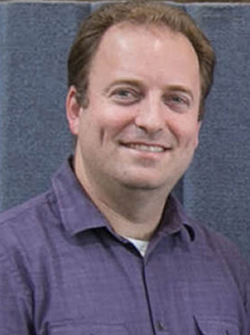 Steve Ross
Steve Ross Steve Ross has made significant contributions to the understanding of underdense plasma conditions using Thomson scattering. He has completed a number of experiments at the Omega Laser Facility at the University of Rochester looking at both low-Z (low atomic number) and high-Z plasma conditions, as well as the physics that drive temperature and density evolution. He also has been instrumental in the development of the NIF optical Thomson scattering diagnostic, which will be fielded on NIF later this year.
“It was a very pleasant surprise to be selected as an EMCR recipient, especially given the large number of smart and talented people I work with here at the Lab,” Ross said. “I’m excited to be able to spend time studying fundamental plasma physics processes at temperatures that rival those found at the center of the sun.”
Tayyab Suratwala has made significant scientific contributions in the fields of optical fabrication and fracture of advanced glasses, resulting in more than 70 peer-reviewed journals and proceedings articles, four patent applications, and two R&D 100 awards. 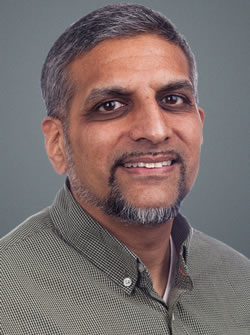 Tayyab SuratwalaIn particular, he has worked on glass grinding and polishing, sub-surface damage measurement and formation, fracture behavior in glasses, fractography, slow crack growth, glass chemistry, sol-gel chemistry, glass melting, and optical properties of glass. He has spoken and given tutorial seminars at a number of companies in the optical fabrication industry, which reflects the level of domestic and international recognition for his research.
Tayyab SuratwalaIn particular, he has worked on glass grinding and polishing, sub-surface damage measurement and formation, fracture behavior in glasses, fractography, slow crack growth, glass chemistry, sol-gel chemistry, glass melting, and optical properties of glass. He has spoken and given tutorial seminars at a number of companies in the optical fabrication industry, which reflects the level of domestic and international recognition for his research.
Suratwala also developed a novel chemical treatment known as the Advanced Mitigation Process to increase laser-damage resistance of optics; processes to prevent thermal and chemically induced fracture in potassium dihydrogen phosphate crystals; and more recently, novel convergent polishing and surface smoothing techniques to produce high-quality optics faster and more cost-effectively (see “Developing New Tools for Smoothing Glass Optics”). Several of these process improvements have been considered by NIF as critical enabling technologies for the success of laser operations.
“LLNL is filled with exceptional talent accomplishing amazing science and delivering novel technologies for our missions,” Suratwala said. “I am truly honored to be part of this institution and to be recognized.”
Director’s Institutional Operational Excellence Awards
Two NIF&PS teams received 2016 Director’s Institutional Operational Excellence Awards. Established in 2007, the awards recognize extraordinary team efforts that have an institutional impact, demonstrate cost savings, and improve Laboratory programs and operations.
Laboratory directorates provided nominations that were cross-directorate, supported institutional goals, and had a significant positive impact on the Laboratory’s mission work.
Receiving awards were the NIF Reliability Program Implementation Team (see “NIF Reliability Program Wins Recognition”) for streamlining maintenance efforts by evaluating maintenance tasks for applicability and effectiveness; and the NIF Scheduling Team for its contributions to substantial NIF operational efficiencies that enabled NIF to fire a total of 417 shots in Fiscal Year 2016 (see “NIF Tops 400 Shots in Fiscal Year 2016”).
 Members of the NIF Scheduling Team (from left) Dan Kalantar, Adam Langro, Chris Choate, Essex Bond, Tom Kohut, Bob Burr, Bob Ehrlich, Angela Cook, Jeremy Kroll, Robert Fallejo, Derrick Lassle, Steve Weaver, and Rich Zacharias with LLNL Director Bill Goldstein (right).
Members of the NIF Scheduling Team (from left) Dan Kalantar, Adam Langro, Chris Choate, Essex Bond, Tom Kohut, Bob Burr, Bob Ehrlich, Angela Cook, Jeremy Kroll, Robert Fallejo, Derrick Lassle, Steve Weaver, and Rich Zacharias with LLNL Director Bill Goldstein (right). Science & Technology Awards
Two NIF&PS teams won 2016 Director’s Science and Technology Awards, honoring them for exceptional accomplishments during the 2015 calendar year. “These awards are intended to recognize scientific and technical achievements that have made a significant impact on the Laboratory, our sponsors, or our mission,” Goldstein said. “These achievements are widely recognized both inside the Laboratory and by the external S&&T community.”
The Advanced Radiographic Capability (ARC) Commissioning Team was cited for completing the high contrast front end and commissioning of ARC, NIF’s petawatt (quadrillion watt)-class laser. ARC is able to produce a brighter source of penetrating, high-energy x rays for target backlighting than is possible with previous NIF x-ray sources. With ARC, researchers can record a series of snapshots revealing the dynamics of NIF target materials under extreme conditions of density, temperature, and pressure.
Team members are Jason Akre, David Alessi, Enrique Anaya, Matthew Arend, Abdul Awwal, Adrian Barnes, Lyle Beaulac, Balbir Bhachu, Erlan Bliss, Paul Bloom, Mike Borden, Mark Bowers, Don Browning, Gordon Brunton, Tracy Budge, Scott Burns, Bob Burr, John Celeste, Leyen Chang, Song Chea, Hui Chen, John Crane, Michael Dailey, William DeHope, Alexander Michael DeLand, Gurcharn Dhillon, Jean-Michel Di Nicola, Pascale Di Nicola, Sham Dixit, Jeremy Dixon, Christophe Dorrer, Eric Downing, Chuck Ellerbee, Gaylen Erbert, Matt Fischer, Barry Fishler, Michael Flegel, Dave Fraga, Brad Golick, Martin Gonzalez, John Halpin, Mathew Hamamoto, Danielle Hare, John Heebner, Mark Hermann, Vincent Hernandez, Doug Homoelle, John Honig, Ron House, Ray Iaea, Dennis Imhoff, Glen James, Russell Johnson, Matthew Johnston, Dan Kalantar, Christopher Kinsella, Kenn Knittel, Jeremy Kroll, Kai LaFortune, Gordon Lau, Janice Lawson, Richard Leach, Henry Lee, Dawn Lord, Roger Lowe-Webb, Jeremy Lusk, Brian MacGowan, Terence Marsh, David Martinez, Warren Massey, David Mathisen, James McBride, Robert Mich, Rodrigo Miramontes-Ortiz, Bill Molander, Sam Montelongo, Jon Nafziger, Brian Nagayama, Raluca Negres, Daniel Nelson, Lyudmila Novikova, Charles Orth, Mitanu Paul, Larry Pelz, Kevin Person, John Peterson, Susan Poor, Michael Pope, Clark Powell, Matt Prantil, Keith Primdahl, Roger Qiu, Bob Reed, Randy Roberts, Oscar Rodriguez, Jay Rouse, Michael Rushford, Richard Sacks, Thad Salmon, Richard Seugling, Mike Shaw, Larry Siegel, Ron Sigurdsson, Stanley Sommer, David Speck, Chris Stolz, Michael Taranowski, Riccardo Tommasini, Richard Vargas, John Vickers, Russell Wallace, Paul Wegner, Pam Whitman, Clay Widmayer, Jeff Wilburn, Scott Wilcox, Karl Wilhelmsen, Wade Williams, Bruce Wilson, Jen Wong, Lana Wong, Steven Yang, Kelly Youngblood, Paul Zapata, Thomas Zobrist and Jon Zuegel.
The Liquid-Deuterium-Filled, Wetted-Foam ICF Target Development and Fabrication Team was honored for developing and fielding NIF target capsules lined with a uniform polymer foam that can be saturated with liquid deuterium and tritium. The “wetted-foam” targets were put to their first test on April 21-22, with good results (see “Solving the Challenges of Making Liquid-Hydrogen Targets”).
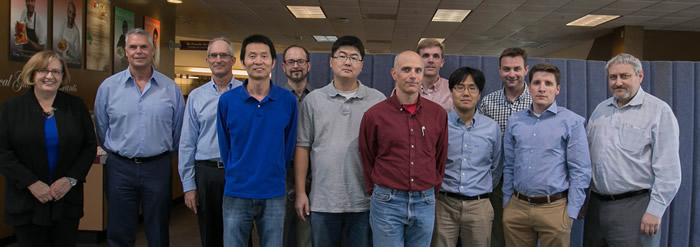 Members of the wetted foam target development and fabrication team with LLNL’s Deputy Director for Science and Technology Pat Falcone (left) and Laboratory Director Bill Goldstein (right). Team members shown are (from left) Tony Van Buuren, Alex Hamza, Yinmin Wang, Christopher Walton, Sung Ho Kim, Bernie Kozioziemski, Trevor Willey, Swanee Shin, Jonathan Lee, and Tom Braun.
Members of the wetted foam target development and fabrication team with LLNL’s Deputy Director for Science and Technology Pat Falcone (left) and Laboratory Director Bill Goldstein (right). Team members shown are (from left) Tony Van Buuren, Alex Hamza, Yinmin Wang, Christopher Walton, Sung Ho Kim, Bernie Kozioziemski, Trevor Willey, Swanee Shin, Jonathan Lee, and Tom Braun.
Team members are Tom Braun, Sung Ho Kim, Monika Biener, Christopher Walton, Bernie Kozioziemski, Morris Wang, Sergei Kucheyev, Swanee Shin, Alex Chernov, Jonathan Lee, Yinmin Wang, Trevor Willey, Marcus Worsley, Tony Van Buuren, Kuang Jen Wu, Alex Hamza, Juergen Biener, Joe Satcher and Christoph Dawedeit.
Excellence in Publication Awards
LLNL’s Deputy Director for Science and Technology Pat Falcone recognized winners of the Excellence in Publication Awards for the 2015 calendar year. “This was an exceptional year for publications,” Falcone said. “The work is just absolutely terrific and it’s a pleasure to be able to celebrate these accomplishments.”
Receiving an award in the applied science category was a paper titled, “Improved Performance of High Areal Density Indirect Drive Implosions at the National Ignition Facility using a Four-Shock Adiabat Shaped Drive” (Physical Review Letters, vol. 115, 105001 (2015)). The authors were Daniel Casey, Jose Milovich, Vladimir Smalyuk, Dan Clark, Harry Robey, Arthur Pak, Andy MacPhee, Kevin Baker, Chris Weber, Tammy Ma, Hye-Sook Park, Tilo Döeppner, Debbie Callahan, Steve Haan, Prav Patel, Luc Peterson, Denise Hoover, Abbas Nikroo, Charles Yeamans, Frank Merrill, Petr Volegov, David Fittinghoff, Gary Grim, John Edwards, Nino Landen, Kai LaFortune, Brian MacGowan, Clay Widmayer, Dan Sayre, Robert Hatarik, Essex Bond, Sabrina Nagel, Laura Benedetti, Nobuhiko Izumi, Shahab Khan, Ben Bachmann, Brian Spears, Charlie Cerjan, Maria Gatu Johnson and Johan Frenje. (See “Shaped Laser Pulse Experiments Boost Understanding of NIF Performance.”)
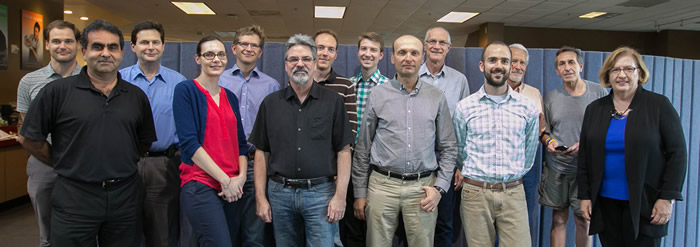 Members of the team that prepared the adiabat shaped drive paper (from left) Dan Sayre, Abbas Nikroo, Nino Landen, Sabrina Nagel, Tilo Döppner, David Fittinghoff, Ben Bachmann, Luc Peterson, Vladimir Smalyuk, Steve Haan, Chris Weber, Harry Robey, and Jose Milovich with Pat Falcone (right). Cited in the basic science category was a paper titled, “X-Ray Diffraction of Solid Tin to 1.2 TPa” (Physical Review Letters, vol. 115 075502 (2015)) by Amy Lazicki, Ryan Rygg, Federica Coppari, Raymond Smith, Dayne Fratanduono, Richard Kraus, Rip Collins, Richard Briggs, David Braun, Damian Swift and Jon Eggert.
Members of the team that prepared the adiabat shaped drive paper (from left) Dan Sayre, Abbas Nikroo, Nino Landen, Sabrina Nagel, Tilo Döppner, David Fittinghoff, Ben Bachmann, Luc Peterson, Vladimir Smalyuk, Steve Haan, Chris Weber, Harry Robey, and Jose Milovich with Pat Falcone (right). Cited in the basic science category was a paper titled, “X-Ray Diffraction of Solid Tin to 1.2 TPa” (Physical Review Letters, vol. 115 075502 (2015)) by Amy Lazicki, Ryan Rygg, Federica Coppari, Raymond Smith, Dayne Fratanduono, Richard Kraus, Rip Collins, Richard Briggs, David Braun, Damian Swift and Jon Eggert. In the postdoc category, Channing Huntington was cited for his paper, “Observation of Magnetic Field Generation Via the Weibel Instability in Interpenetrating Plasma Flows” (Nature Physics, vol. 11 (2015)). Huntington thanked “all of my co-authors who helped tremendously with the Weibel Instability project.”
In the student category, Hans Rinderknecht was cited for his paper, “Ion Thermal Decoupling and Species Separation in Shock-Driven Implosions” (Physical Review Letters, vol. 114, 025001 (2015)).



